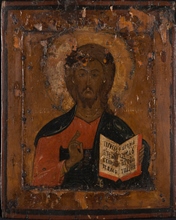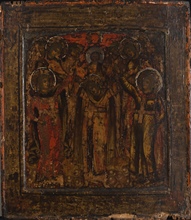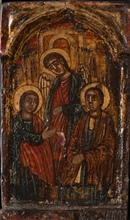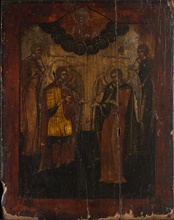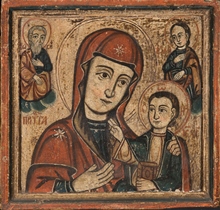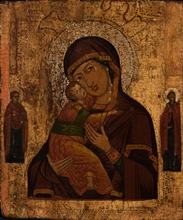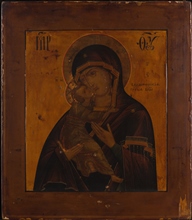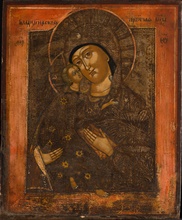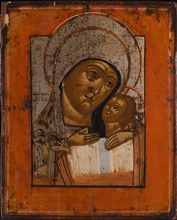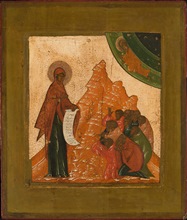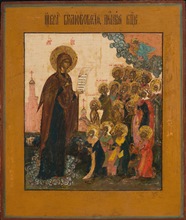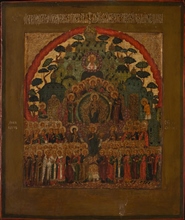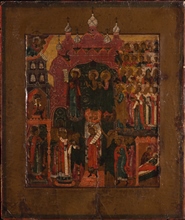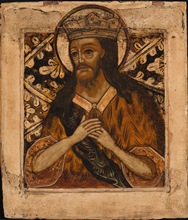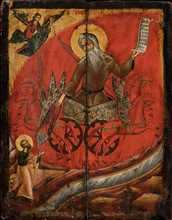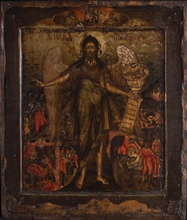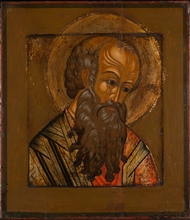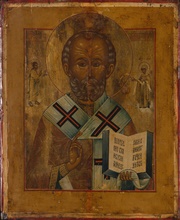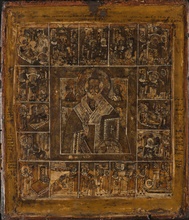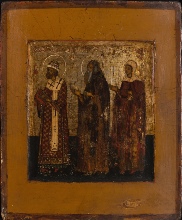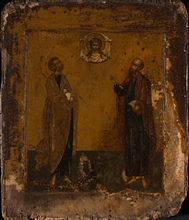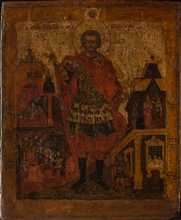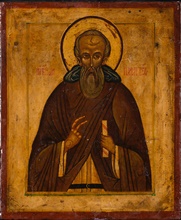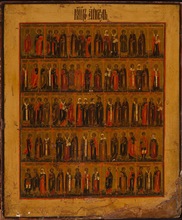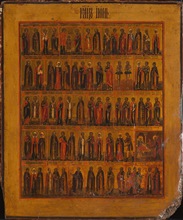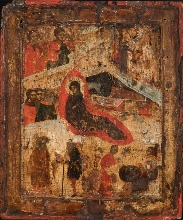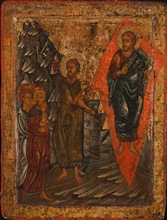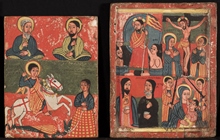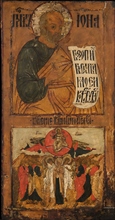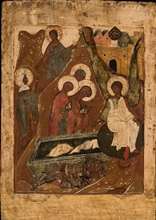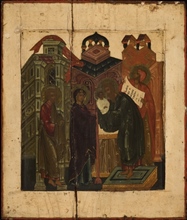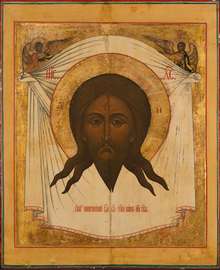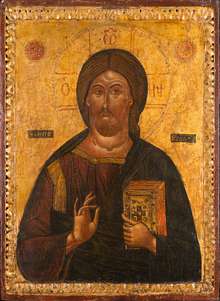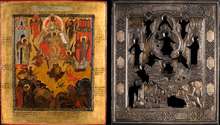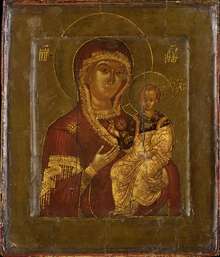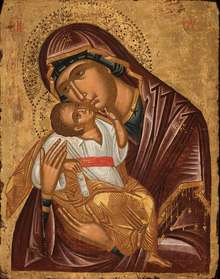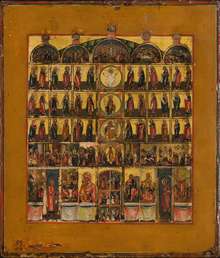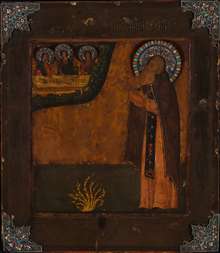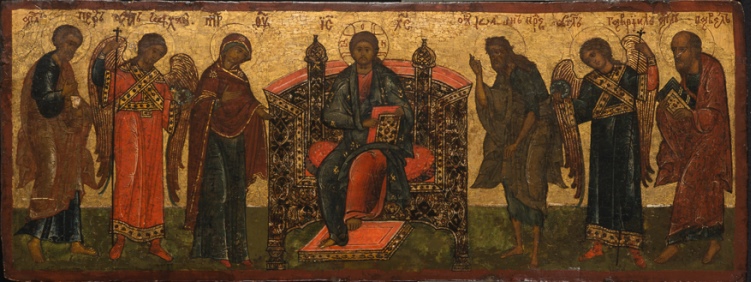
The Icons from the Gürtler Donation
Icons—the Greek word eikon (εἰκών) means image, likeness—play a central role in the Orthodox Church. Based on legends of miracles, they function as mediators between this world and the next. After the fall of the Byzantine Empire, they experienced a diverse continued existence especially in Russia, but also in Greece and the Balkans. The style of depiction, which was protected from Western influences by geographic and political distance, presents a self-contained universe of images with a particularly strong visual narrative element. An extraordinary donation in 2013 provided the Kunstmuseum St. Gallen with an extensive, superb collection in this area: Dr. med. René and Lotti Gürtler bequeathed over 150 wooden and metal icons from the 16th to the 19th centuries as well as some 40 small antiques, a precious Slavic manuscript, and Middle European sculptures of saints to the museum in order to preserve them in their entirety.
Numerous miracles are ascribed to icons. According to tradition, they are also produced by the depicted saints themselves and are the basis for the creation of the most sacred panel paintings not created by human hands. Among these pictures with miraculous origins are the Mandylion, a cloth image that is said to be an imprint of Christ’s face. As an acheiropoietos, it is thus considered not made by human hands. Numerous legends explain its origins, such as that of the Mandylion of Edessa: Christ is said to have sent the cloth with the imprint of his face to the ailing King Abgar of Edessa, who was subsequently cured by it. Thus, the cloth was ascribed the same healing powers as the Son of God’s physical presence.
This pictorial type, which has been documented since the 6th century, shows the face of Christ usually without the neck: isolated from the context of the body and thus consistent with its origin legend. In the icon from the Gürtler Collection, Christ is shown middle-aged with shoulder-length brown hair parted in the middle arranged in three points and with a long full beard. A cloth behind him is held up by angels.
From early on, Christian theology considered images, which were shaped by classical, pagan culture, critical to its own development. Thus, it was necessary to provide a theological basis for the veneration of images or icons (eikon means “image, likeness”). While the Old Testament forbids making likenesses of God, in the New Testament God was made visible in the form of his son Jesus Christ. The Mandylion is considered fundamental in justifying the veneration of icons. In the question of whether the incarnated Son of God could be depicted, it serves as a sort of divine confirmation: it claims to be the true portrait of Christ, a proto-image that could be referenced by theologians and imitated by icon painters. Thus, it is considered the first icon ever; since then, all copies of this divine original image have been called icons.
The icon Christ Pantocrator shows the Son of God in a half-length frontal view as Ruler of All. Compared with earlier depictions, his portrayal here underlines his masculinity, with a stern gaze, beard, and well-kept, shoulder-length hair parted down the middle. This style of representation was established in the 4th century and radically broke with then common symbolic representations of Christ—for example, as a lamb.
Already at the First Council of Nicaea in 325, it was affirmed that Christ is the visible image of the Father. This was followed by a centuries-long discourse on the divine nature of Christ and the question of his representability. At the Council of Chalcedon in 451, the following dogma was established: Christ unites both human and divine nature—he is “a true god and a true man.” His portrayal was approved by the Second Council of Nicaea in 787 on the basis of his incarnation, so long as the object of adoration was not the image itself but its archetype. In this context, Theodorus of Studios (759–826) declared: “In his flawlessness, Christ not only can be worshipped in picture form, he must be.” Thus, the type of Christ Pantocrator is a symbol of the debate that only ended in 843 with the ultimate triumph of the veneration of icons.
In such depictions, the large nimbus includes Christ’s monogram: “Ho Ōn,” meaning “the Existing One” (Jesus Christ, Ruler of All). His right hand is raised in a gesture of blessing; in his left, the Son of God carries a richly decorated codex. The golden background, representing his divinity, is framed by gilded carvings.
Allegorical themes appeared in Russia in the 16th century. While their origin can be traced to Serbia in 1300, they came to define above all a new pictorial type of traditional icon painting two centuries later in Russia: symbolic and didactic icons. These are based on the liturgical hymnography, which they typically follow very precisely, sometimes quoting its texts in inscriptions. These icons include the Only-Begotten Son, My Soul Glorifies the Lord, He Who Does Not Sleep, and the Mother of God with Unburnt Bush.
The type of the Only-Begotten Son is based on the Hymn of the Divine Liturgy of Emperor Justinian (527–565), an oft-sung hymn in the Orthodox Church, and symbolizes Christ’s triumph over death.
After the figure of Christ as the foundational image of all icons, the Mother of God is the most venerated. This veneration began in the 5th century, after negotiations at the Council of Ephesus in 431 bestowed upon her the title of Theotokos (“she who gave birth to God”). The pictorial type of the Mother of God is based on the Hodegetria (“she who shows the way”), which is considered the most sublime image of Mary. This image originated in an eponymous monastery in Constantinople founded in the 9th century that was devoted to the care of the blind.
After icon venerators emerged triumphant in 843 from the Byzantine iconoclasm in the Eastern Church, the type of the Hodegetria spread widely in both icons and monumental paintings. Countless images were created and became widespread, such as Our Lady of Kazan, Our Lady of Smolensk, and Our Lady of Tikhvin. They all combine the essential features of the Hodegetria: bust with respectful distance between mother and child and observer; strict frontal pose; Christ child sitting on the left arm of his mother, his right hand lifted in a gesture of blessing and his left hand holding a rolled-up scroll; Mary’s right hand pointing reverentially to the child. Just as the Hodegetria protected the city of Constantinople from enemy attacks on several occasions, its images are also associated with miraculous legends.
The Glykophilousa, the “sweetly kissing,” holds the child in both hands. The child looks up at her and touches her neck or nestles into her cheek. While the Christ child is sometimes depicted at play, the mother retains her serious expression, aware of her son’s fate. This tender representation enjoyed great popularity in many countries.
The icon Our Lady the Glykophilousa from the Gürtler Collection boasts a precious background of gold leaf; the haloes are perforated with a pattern of rosettes, and the Christ child’s mantle is decorated with chrysography (gold highlighting). Mary’s dark red maphorion is also impressive, with its gold edging and further ornaments; the creases are schematic and expressive. The rubbed-off monograms identify the depicted as “Jesous Christos,” Jesus Christ, and “Meter Theou,” Mother of God.
This type of the Mother of God, as well as Our Lady of Vladimir, is part of the Eleusa Umilenie group. Unlike the Hodegetria group, this group is noteworthy for the intimate relationship between Mary and the Christ Child. To this end, it does without a strict frontal depiction. The Hodegetria and the original Glykophilousa also share a common legend of their divine creation: both are said to have been painted by Saint Luke, patron saint of painters.
The iconostasis, a high wall of pictures in the church, is a liturgical structure that separates the chancel from the nave. It developed out of the early Christian templon, a room divider comprising a marble balustrade, columns, and an architrave. In the middle, a door permitted the clergy access to the sanctuary. In the Orthodox house of God, the iconostasis pictorially recapitulates the theology of the Eastern Church as a “summa.” In several tiers, icons are arranged according to a predetermined pattern.
This wall of pictures was recreated on household icons for private worship and in miniature on collapsible, portable icons for succor while traveling. For this purpose, a number of individual icons would be combined in finely detailed painting: a challenge for artists and at the same time a chance to prove their painterly skill.
Saint Sergius of Radonezh (1314–1392) is one of the most popular saints in Russia. Comparable to Saint Francis of Assisi in the Western Church, the eremite preached humility, penitence, and charity.
After a vision, he founded the Holy Trinity monastery in Sergiyev Posad. Around 1411, the monk Andrei Rublev (ca. 1360–1430) created the famous icon The Holy Trinity, invoking the teachings of the saint, who had died a few years earlier. This masterpiece, which is now held at the Tretyakov Gallery in Moscow, was declared by the Eastern Church in 1551 as the model for representations of the Trinity. The Old Testament Trinity after Rublev’s model, with the three angels leaning toward each other at the altar and touching a chalice symbolizing the Eucharist, appears in the Gürtler Collection icon in the upper left corner as a vision of Sergius of Radonezh.
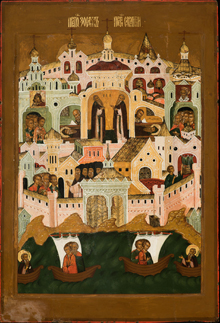
The icon of Saints Zosima and Savvati is a true masterpiece. It shows in great detail the monastery on the Solovatsky Islands founded by St. Zosima (d. 1478). St. Savvati (d. 1435) had already initiated the founding of a monastery on the island a few decades earlier. His monastery, however, did not survive.
The foreground of the icon suggests a sea with pilgrim boats; on the left and right, Zosima and Savvati steer boats toward the center of the picture. The island takes up the entire top portion of the picture, densely filled with numerous pastel-colored buildings. Their vertical arrangement gives the impression of a walled city with a golden entrance gate. Domes, crosses, and towers distinguish the architecture of the religious buildings. In the center of the picture, the two saints are portrayed as old men, with beards and straight hair. They appear full length in an opening in the main church, their arms raised in intercession toward heaven. In a simultaneous view, they are shown immediately beside this scene interred in their graves, with genuflecting pilgrims above them. In the rest of the monastery complex, the painter has depicted scenes from everyday monastery life, such as the reception and escort of groups of pilgrims at the bottom left.
Saints Zosima and Savvati were canonized in Moscow in 1547 and are portrayed together because of their common feast day, despite the fact they did not reside on Solovetsky at the same time. This difference in time is broken down in order to portray both of their achievements. Comparable to this detailed painting and exceptionally sophisticated depiction of the subject matter, vita icons portray various scenes from the life of a saint in a kind of synopsis in one pictorial field. With his detailed arrangement of the buildings open at the front and the vertical layout of the imposing coastal city, the painter of this Russian Zosima and Savvati icon developed an even more sophisticated and masterful imagery.
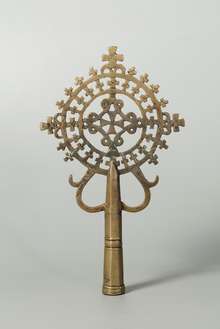
The Gürtler Collection also includes numerous liturgical objects, some of which date to the Byzantine Empire. These include cross pendants, handheld crosses, and processional crosses from Ethiopia.
The earliest documented appearance of the cross as a Christian symbol in Ethiopia was on coins from the reign of King Ezana in the 4th century. It remains a central religious symbol, a sign of victory, mercy, and proclamation of faith. It can be divided into three major groups based on its intended use: cross pendants worn around the neck, handheld crosses, and processional crosses. The latter, which have been produced since the 12th century, are the largest of the three and exhibit the most elaborate designs. A hollow shaft made it possible to mount the cross on a wooden pole and thus lengthen it so that church dignitaries could hold it above the heads of the faithful during a ceremony. Copper, bronze, and iron were the preferred materials; later, in the 16th century, brass was also used.
Both examples from the Gürtler Collection represent a common form of early copper crosses clearly produced in the province of Lasta, known as Lalibela crosses. Their place of origin, the holy city Lalibela, is also called New Jerusalem. The city’s 800-square-meter church, now recognized as a UNESCO World Heritage site, was hewn from the area’s cliffs and serves as an important pilgrimage site for the Orthodox Church.
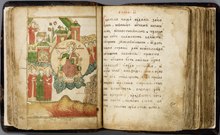
This manuscript from the Russian liturgy unites eight texts related primarily to the Last Judgment and the Passion of Christ. Until the end of the 19th century, it was common especially among Old Believers (who were not allowed to operate their own presses in the Russian empire) to disseminate theological texts written by hand and gather these together in a single volume to celebrate mass.
The first two texts belong to the realm of eschatology (from the ancient Greek és-chata, meaning extreme or final things, and lógos, or lesson). They describe the prophetic teaching of the Final Judgment of individuals as well as all of Creation, and thus the advent of a new world. These are followed by four short texts on building a pious life, and then the story of the Passion of Christ, which takes up over half the collected volume.
Most recent scientific results and insights
The Kunstmuseum St. Gallen views the Gürtler Collection as a platform for research and exchange related to icons, where knowledge can continue to be expanded and new insights can be gained. On the museum’s website, current research will be made available to interested members of the public. The Kunstmuseum St. Gallen looks forward to receiving feedback and suggestions to promote further exchange and insight.
